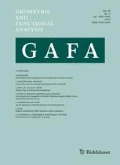Abstract
We introduce a new probabilistic technique for finding ‘almost-periods’ of convolutions of subsets of groups. This gives results similar to the Bogolyubovtype estimates established by Fourier analysis on abelian groups but without the need for a nice Fourier transform to exist. We also present applications, some of which are new even in the abelian setting. These include a probabilistic proof of Roth’s theorem on three-term arithmetic progressions and a proof of a variant of the Bourgain–Green theorem on the existence of long arithmetic progressions in sumsets A+B that works with sparser subsets of {1, . . . , N} than previously possible. In the non-abelian setting we exhibit analogues of the Bogolyubov–Freiman–Halberstam–Ruzsa-type results of additive combinatorics, showing that product sets A 1 · A 2 · A 3 and A 2 · A −2 are rather structured, in the sense that they contain very large iterated product sets. This is particularly so when the sets in question satisfy small-doubling conditions or high multiplicative energy conditions. We also present results on structures in A · B.
Our results are ‘local’ in nature, meaning that it is not necessary for the sets under consideration to be dense in the ambient group. In particular, our results apply to finite subsets of infinite groups provided they ‘interact nicely’ with some other set.
Similar content being viewed by others
References
N. Alon, J.H. Spencer, The Probabilistic Method, 3rd ed. John Wiley & Sons, 2008.
Bogolioùboff N. (1939) Sur quelques propriétés arithmétiques des presque-périodes. Ann. Chaire Phys. Math. Kiev 4: 185–205
B. Bollobás, Random Graphs, 2nd ed., CUP, 2001.
J. Bourgain, On arithmetic progressions in sums of sets of integers, A tribute to Paul Erdős, CUP (1990), 105–109.
Bourgain J. (2008) Roth’s theorem on progressions revisited. J. Anal. Math. 104: 155–192
E. Breuillard, B. Green, Approximate groups, I: the torsion-free nilpotent case, Journal of the Inst. of Math. Jussieu, available on CJO 02 Jun 2010, doi:10.1017/S1474748010000150
Breuillard E., Green B. (2010) Approximate groups, II: the solvable linear case. Quart. J. Math. 00: 1–9
E. Breuillard, B. Green, T. Tao, Linear approximate groups, preprint (2010); arXiv:1001.4570
Bukh B. (2008) Sums of dilates. Combin. Probab. Comput. 17(5): 627–639
Chang M.-C. (2002) A polynomial bound in Freiman’s theorem. Duke Math. J. 113(3): 399–419
Chvátal V. (1979) The tail of the hypergeometric distribution. Discrete Math. 25(3): 285–287
E. Croot, I.Z. Ruzsa, T. Schoen, Arithmetic progressions in sparse sumsets, Combinatorial Number Theory, de Gruyter, Berlin (2007), 157–164.
Croot E., Sisask O. (2009) A new proof of Roth’s theorem on arithmetic progressions. Proc. Amer. Math. Soc. 137(3): 805–809
E. Croot, O. Sisask, A note on proving Roth’s theorem using Bogolyubov’s method, note available at http://people.math.gatech.edu/~ecroot/expository.html
D. Fisher, N.H. Katz, I. Peng, On Freiman’s theorem in nilpotent groups, preprint (2009); arXiv:0901.1409
G.A. Freiman, Foundations of a Structural Theory of Set Addition, Translations of Mathematical Monographs 37, AMS (1973).
Freiman G.A., Halberstam H., Ruzsa I.Z. (1992) Integer sum sets containing long arithmetic progressions. J. London Math. Soc. (2) 46(2): 193–201
Green B. (2002) Arithmetic progressions in sumsets. Geom. Funct. Anal. 12(3): 584–597
B. Green, Review MR2429639 (2009k:11023) of [ŁuS], Mathematical Reviews, available at http://www.ams.org/mathscinet-getitem?mr=2429639
Green B., Ruzsa I.Z. (2007) Freiman’s theorem in an arbitrary abelian group. J. Lond. Math. Soc. (2) 75(1): 163–175
Green B., Ruzsa I.Z. (2006) Sets with small sumset and rectification. Bull. London Math. Soc. 38(1): 43–52
B. Green, T. Sanders, T. Tao, Personal communication.
Hoeffding W. (1963) Probability inequalities for sums of bounded random variables. J. Amer. Statist. Assoc. 58: 13–30
E. Hrushovski, Stable group theory and approximate subgroups, preprint (2009); arXiv:0909.2190
S. Janson, Large deviation inequalities for sums of indicator variables, Tech. Report 1994:34, Uppsala; available at http://www.math.uu.se/~svante/papers/index.html
V.F. Lev, Character-free approach to progression-free sets, preprint (2009); arXiv:0911.0513
V.F. Lev, Reconstructing integer sets from their representation functions, Electron. J. Combin. 11:1 (2004), Research Paper 78, 6 pp. (electronic).
Łuczak T., Schoen T. (2008) On a problem of Konyagin. Acta Arith. 134(2): 101–109
Meshulam R. (1995) On subsets of finite abelian groups with no 3-term arithmetic progressions. J. Combin. Theory Ser. A 71(1): 168–172
D.H.J. Polymath, A new proof of the density Hales–Jewett theorem, preprint (2009); arXiv:0910.3926
L. Pyber, E. Szabó, Growth in finite simple groups of Lie type, preprint (2010); arXiv:1001.4556
Roth K.F. (1953) On certain sets of integers. J. London Math. Soc. 28: 104–109
Ruzsa I.Z. (1991) Arithmetic progressions in sumsets. Acta Arith. 60(2): 191–202
Ruzsa I.Z. (1994) Generalized arithmetical progressions and sumsets. Acta Math. Hungar. 65(4): 379–388
I.Z. Ruzsa, E. Szemerédi, Triple systems with no six points carrying three triangles, Combinatorics (Proc. Fifth Hungarian Colloq., Keszthely, 1976), Vol. II, Colloq. Math. Soc. János Bolyai 18, North-Holland, Amsterdam-New York (1978). 939–945,
Sanders T. (2008) Additive structures in sumsets. Math. Proc. Cambridge Philos. Soc. 144(2): 289–316
Sanders T. (2010) On a non-abelian Balog–Szemerédi-type lemma. J. Aust. Math. Soc. 89: 127–132
Sanders T. (2009) Three-term arithmetic progressions and sumsets. Proc. Edinb. Math. Soc. (2) 52(1): 211–233
O. Sisask, Bourgain’s proof of the existence of long arithmetic progressions in A + B, note (2009); available at http://www.maths.qmul.ac.uk/~olof/
E. Szemerédi, An old new proof of Roth’s theorem, Additive combinatorics, CRM Proc. Lecture Notes 43, Amer. Math. Soc., Providence, RI (2007), 51–54.
T. Tao, Finite subsets of groups with no finite models, blog post available at http://terrytao.wordpress.com/2008/10/06/finite-subsets-of-groupswith-no-finite-models/+ (2008).
Tao T. (2010) Freiman’s theorem for solvable groups. Contrib.. Discrete Math. 5(2): 137–184
Tao T. (2008) Product set estimates for non-commutative groups. Combinatorica 28(5): 547–594
T. Tao, V.H. Vu, Additive combinatorics, CUP (2006).
Varnavides P. (1959) On certain sets of positive density. J. London Math. Soc. 34: 358–360
Author information
Authors and Affiliations
Corresponding author
Rights and permissions
About this article
Cite this article
Croot, E., Sisask, O. A Probabilistic Technique for Finding Almost-Periods of Convolutions. Geom. Funct. Anal. 20, 1367–1396 (2010). https://doi.org/10.1007/s00039-010-0101-8
Received:
Accepted:
Published:
Issue Date:
DOI: https://doi.org/10.1007/s00039-010-0101-8
Keywords and phrases
- additive combinatorics
- almost-periodicity
- arithmetic progressions
- Bogolyubov’s method
- convolution
- Freiman’s theorem
- product sets
- sumsets



